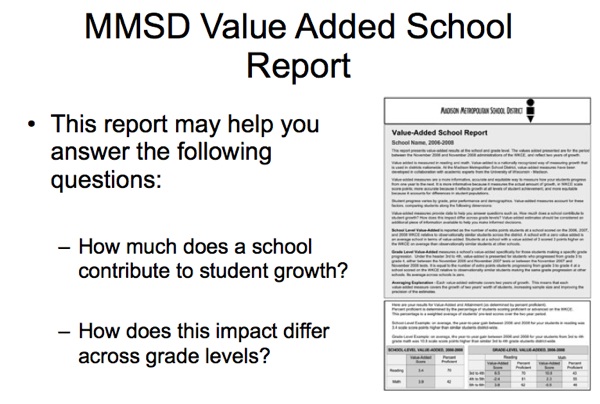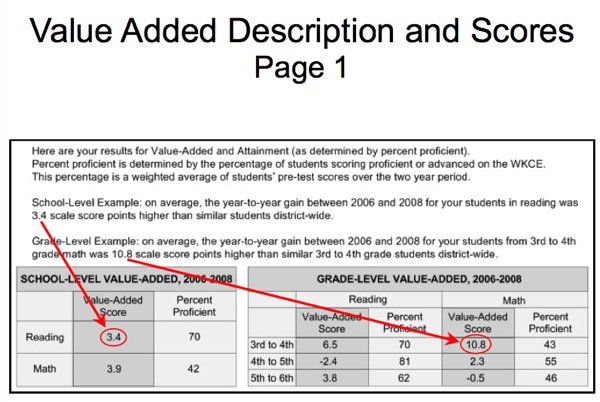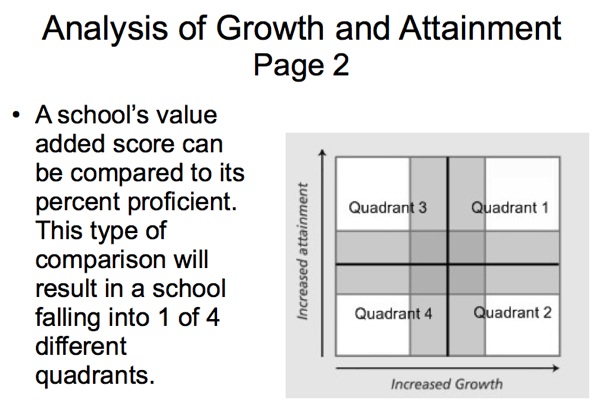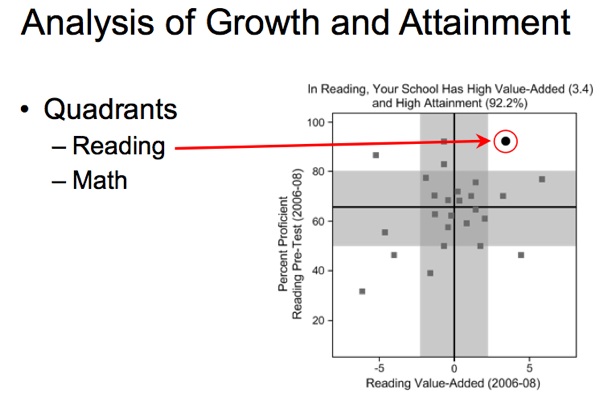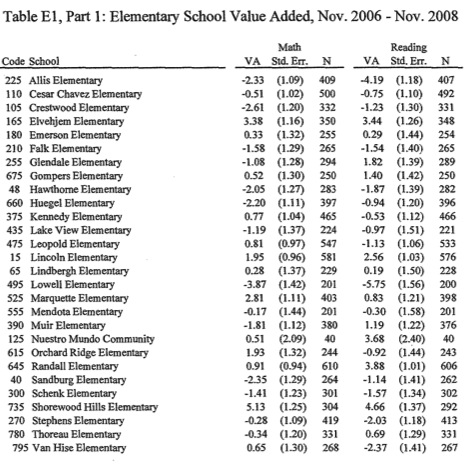Value added is the use of statistical technique to isolate the contributions of schools to measured student knowledge from other influences such as prior student knowledge and demographics. In practice, value added focuses on the improvement of students from one year to the next on an annual state examination or other periodic assessment. The Value-Added Research Center (VARC) of the Wisconsin Center for Education Research produces value-added measures for schools in Madison using the Wisconsin Knowledge and Concepts Examination (WKCE) as an outcome. The model controls for prior-year WKCE scores, gender, ethnicity, disability, English language learner, low-income status, parent education, and full academic year enrollment to capture the effects of schools on student performance on the WKCE. This model yields measures of student growth in schools in Madison relative to each other. VARC also produces value-added measures using the entire state of Wisconsin as a data set, which yields measures of student growth in Madison Metropolitan School District (MMSD) relative to the rest of the state.
Some of the most notable results are:
1. Value added for the entire district of Madison relative to the rest of the state is generally positive, but it differs by subject and grade. In both 2008-09 and 2009-10, and in both math and reading, the value added of Madison Metropolitan School District was positive in more grades than it was negative, and the average value added across grades was positive in both subjects in both years. There are variations across grades and subjects, however. In grade 4, value-added is significantly positive in both years in reading and significantly negative in both years in math. In contrast, value-added in math is significantly positive–to a very substantial extent–in grade 7. Some of these variations may be the result of the extent to which instruction in those grades facilitate student learning on tested material relative to non-tested material. Overall, between November 2009 and November 2010, value-added for MMSD as a whole relative to the state was very slightly above average in math and substantially above average in reading. The section “Results from the Wisconsin Value-Added Model” present these results in detail.
2. The variance of value added across schools is generally smaller in Madison than in the state of Wisconsin as a whole, specifically in math. In other words, at least in terms of what is measured by value added, the extent to which schools differ from each other in Madison is smaller than the extent to which schools differ from each other elsewhere in Wisconsin. This appears to be more strongly the case in the middle school grades than in the elementary grades. Some of this result may be an artifact of schools in Madison being relatively large; when schools are large, they encompass more classrooms per grade, leading to more across-classroom variance being within-school rather than across-school. More of this result may be that while the variance across schools in Madison is entirely within one district, the variance across schools for the rest of the state is across many districts, and so differences in district policies will likely generate more variance across the entire state. The section “Results from the Wisconsin Value-Added Model” present results on the variance of value added from the statewide value-added model. This result is also evident in the charts in the “School Value-Added Charts from the MMSD Value-Added Model” section: one can see that the majority of schools’ confidence intervals cross (1) the district average, which means that we cannot reject the hypothesis that these schools’ values added are not different from the district average.
Even with a relatively small variance across schools in the district in general, several individual schools have values added that are statistically significantly greater or less than the district average. At the elementary level, both Lake View and Randall have values added in both reading and math that are significantly greater than the district average. In math, Marquette, Nuestro Mundo, Shorewood Hills, and Van Hise also have values added that are significantly greater than the district average. Values added are lower than the district average in math at Crestwood, Hawthorne, Kennedy, and Stephens, and in reading at Allis. At the middle school level, value added in reading is greater than the district average at Toki and lower than the district average at Black Hawk and Sennett. Value added in math is lower than the district average at Toki and Whitehorse.
3. Gaps in student improvement persist across subgroups of students. The value-added model measures gaps in student growth over time by race, gender, English language learner, and several other subgroups. The gaps are overall gaps, not gaps relative to the rest of the state. These gaps are especially informative because they are partial coefficients. These measure the black/white, ELL/non-ELL, or high-school/college-graduate-parent gaps, controlling for all variables available, including both demographic variables and schools attended. If one wanted to measure the combined effect of being both ELL and Hispanic relative to non-ELL and white, one would add the ELL/non-ELL gap to the Hispanic/white gap to find the combined effect. The gaps are within-school gaps, based on comparison of students in different subgroups who are in the same schools; consequently, these gaps do not include any effects of students of different subgroups sorting into different schools, and reflect within-school differences only. There does not appear to be an evident trend over time in gaps by race, low-income status, and parent education measured by the value-added model. The section “Coefficients from the MMSD Value-Added Model” present these results.
4. The gap in student improvement by English language learner, race, or low-income status usually does not differ substantively across schools; that between students with disabilities and students without disabilities sometimes does differ across schools. This can be seen in the subgroup value-added results across schools, which appear in the Appendix. There are some schools where value-added for students with disabilities differs substantively from overall value- added. Some of these differences may be due to differences in the composition of students with disabilities across schools, although the model already controls for overall differences between students with learning disabilities, students with speech disabilities, and students with all other disabilities. In contrast, value-added for black, Hispanic, ELL, or economically disadvantaged students is usually very close to overall value added.
Value added for students with disabilities is greater than the school’s overall value added in math at Falk and Whitehorse and in reading at Marquette; it is lower than the school’s overall value added in math at O’Keefe and Sennett and in reading at Allis, Schenk, and Thoreau. Value added in math for Hispanic students is lower than the school’s overall value added at Lincoln, and greater than the school’s overall value added at Nuestro Mundo. Value added in math is also higher for ELL and low-income students than it is for the school overall at Nuestro Mundo.
